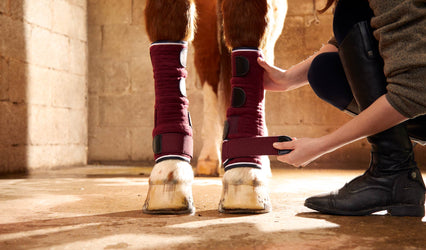Posted
What To Do - Horse Leg Swelling During Winter
With winter incoming, it means for many of us that our horses may need to be stabled for longer periods due to the weather. When restricted to the stable, some horses can show signs of swollen or puffy legs after being stood in for longer lengths of time. Try not to worry too quickly if your horse shows these signs; take a closer look and decipher the issue as best you can to help ease the symptoms and know when to call your vet. You may be able to treat the issue with the use of cold water treatment in the form of cold hosing or horse boots used for cooling.
When To Call Your Vet For Swollen Horse Legs
With swelling there can be various accompanying issues. If your horse is showing obvious signs of pain or distress, we would recommend you call your vet as soon as possible, and try to safely calm and comfort your horse without putting neither yourself nor your horse in harm's way. If there are any signs of exaggerated heat in the leg or swollen area; this could be a sign of infection and could require treatment and/or antibiotics so you would require veterinary advice as to the best course of action.

Checking For Wounds
Check closely down the leg and surrounding area for any wounds - this could be the initial cause of the swelling and will need to be treated. Depending on severity, you may be able to treat this wound safely at home, but we would recommend seeking veterinary advice to support your decision. If you cannot find any related signs for the swelling, it may be worth taking your horse out of the stable and walking and/or trotting up the horse to check for any obvious signs of lameness that could be the cause. Depending on the area in question, you may seek advice from either your vet or your farrier, or both if necessary. If you are unsure, do not be afraid to ask for a second opinion - your horse's health is paramount.
So why do legs sometimes swell when stabled or on box rest? Due to restricted movement, the general blood flow is decreased - much as if we stood still all day without much movement. This causes fluid build-up due to gravity, around the lower extremities of the leg (typically around the tendon and pastern areas), which appears as swelling. Often older horses are more prone to this due to natural decreased circulation which is common consequence of age.

Treating Horse Leg Swelling
To treat mild swelling at home, there are some steps you can take to help alleviate the issue. A good start would be to cool the leg. The most practical option is to use cold water boots. There are many variations of these, namely the Premier Equine Cold Water Horse Boots or the Cold Water Compression Horse Boots. These are activated by being submerged in cold water, then fitted to the tendon/fetlock area to help cool and relieve the heat.
If you feel like you need something colder - you could opt for horse ice boots. With these you can insert crushed ice into the pockets and apply securely to the leg, with an intense cooling effect. During the winter especially, cold hosing can be quite impractical and dangerous as the continuous run-off of the excess water can expose you to treacherously slippery areas or ice! If you do find use or end up with a slippery surrounding surface, you can use bedding, salt or sand to help reduce the risk accordingly.
Improving Circulation
If possible, it is always best to encourage your horse to move to increase the circulation and help to disperse the build-up of fluid. Gentle exercise could be an option if you have facilities or good ground to work on, if not you could carefully hand walk your horse to help them stretch and release the fluid retention. A good thorough groom or strapping also helps to increase blood flow and circulation - so this is also a good addition.

Helpful Boots, Bandages, and Legwear
As preventative and precautionary measures, it may be worth considering magnetic horse products - such as the Magnetic Horse Boot Wraps or Fetlock Boots. These products can help to increase the natural circulation to help reduce the risk of inflammation in that area. A traditional and trusted preventative method is bandaging the legs for compression. This helps to reduce and control any natural swelling incurred when stood in, whilst providing support to the tendons and ligaments.
If despite these steps; your horse still has regular swelling in the limbs or you are unsure in any way at all - please contact your vet for further advice.


